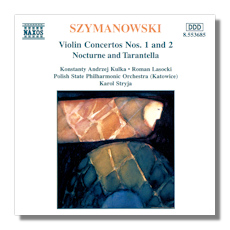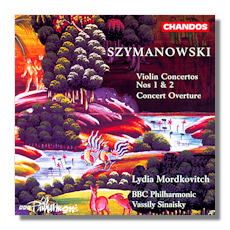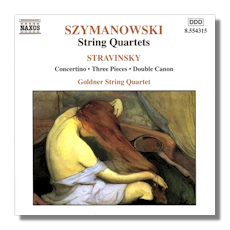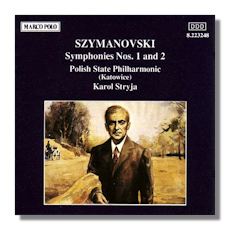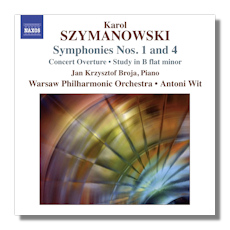
The Internet's Premier Classical Music Source
Related Links
-
Find CDs & Downloads
Amazon - UK - Germany - Canada - France - Japan
ArkivMusic - CD Universe
Find DVDs & Blu-ray
Amazon - UK - Germany - Canada - France - Japan
ArkivMusic-Video Universe
Find Scores & Sheet Music
Sheet Music Plus -
Recommended Links
Site News
Karol Szymanowski
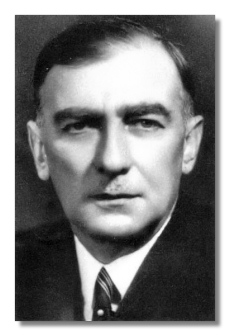
(1882 - 1937)
The work of Karol Szymanowski (October 3, 1882 - March 29, 1937), the great Polish composer between the death of Chopin and the rise of the post-World War II generation of Grażyna Bacewicz and Witold Lutosławski, divides into three periods: a Straussian phase; a flirtation with Impressionism; a nationalist final period influenced by Polish folklore.
He began, however, strongly opposed to folk material as a source for Polish music and considered it provincial. We should remember, however, that Poland, at this point a duchy of the Russian empire, did not become an official nation until after the First World War. Nationalism was expressed mainly through the Catholic Church and through identification with either Chopin or Western Europe – that is, against Russia. After graduating from the Warsaw Music Institute (now, the Conservatory), Szymanowski became involved with a group that called itself Young Poland and included the composer and conductor Grzegorz Fitelberg and composer Ludomir Różycki. His music began to get played in both Poland and Germany. To this period belong the Concert Overture (1906) and his First Symphony (1907). However, Szymanowski began to travel. In 1911 and 1912, he travelled to Vienna, where they performed his Second Symphony (1910), still very much influenced by the gigantism of Richard Strauss and the fussy Germanic counterpoint deriving from Max Reger. However, in 1914 he also visited Sicily and North Africa, awakening an interest in oriental exoticism. Of more musical significance, he also travelled to Paris, where he came into contact with French and Russian music. Debussy and Ravel influence his orchestration and loosen (although do not obliterate) his dependence on Germanic functional harmony. He also became affected by the music of Scriabin. The music in general becomes more Impressionistic and culminates in the First Violin Concerto and the Third Symphony, "Song of the Night," both from 1916.
The combination of the Russian Revolution and the First World War precipitated a crisis in Szymanowski's life. His family lost most of their money and all of their land. He began to doubt his artistic capability. From 1918 to 1921, he wrote very little. The ballet-pantomime Mandragora (1920) is probably his most substantial work of the period. He began an opera, King Roger – a kind of rewrite of Euripides's The Bacchae – but stopped before completing the last act. When he took up the opera again, he ran into the difficulty that the Impressionism of the earlier part was no longer what he wanted to do. Nevertheless, he did complete the work in 1924. The finale, a resplendent hymn to the sun, shows absolutely no trace of the effort it cost him to "think himself back" into the earlier style.
Influenced by Stravinsky's appropriation of folk materials, Szymanowski began to assimilate rural Polish folk music into a highly sophisticated and very modern style. In essence, he trades the hothouse exoticism of ancient Persia and Greece for the Tatra mountains in southern Poland – remote, wild, and "primitive." One must note that Szymanowski doesn't tap into this solely for nationalistic reasons, although the founding of the new Polish State probably affected him. The primitivism of the region appealed to him just as strongly – a new version of the Dionysian exotic closer to home, if you will, than Athens or Baghdad. At any rate, it toughened his music, which could get lost in languid lilies. He spent much of his time in Paris, receiving commissions for such works as his Stabat Mater (1926). He also became recognized at home. In 1927, he became director of the Warsaw Conservatory, but reactionary forces eventually drove him out (1929). That same year, he was diagnosed with severe tuberculosis. Excessive smoking and drinking didn't help, and he cut back, leading to improvement in his health. In 1930, he became rector of the Warsaw Music Institute. Two years later, however, the old guard again drove him out. His health declined again. Nevertheless, he managed to compose his radiant Violin Concerto #2 (1933), the intense and austere Litany to the Virgin Mary (1933), the Fourth Symphony (1933), an interesting commingling of his primitivism with neo-classicism, and the ballet Harnasie (1935), perhaps his purest expression of folk spirit.
Szymanowski's final years were marked by destitution and illness. His financial precariousness forced him to undertake punishing tours, which further damaged his health. He finally succombed in 1937. ~ Steve Schwartz

Recommended Recordings
Concertos for Violin
- Violin Concertos #1 & 2; Nocturne & Tarantella/Marco Polo 8.223291 or Naxos 8.553685
-
Konstanty Andrzej Kulka & Roman Lasocki (violin), Karol Stryja/Polish State Philharmonic Orchestra, Katowice
Amazon - UK - Germany - Canada - France - Japan
Or reissued as Naxos 8.553685
Amazon - UK - Germany - Canada - France - Japan - ArkivMusic - CD Universe
- Violin Concertos #1 & 2, Opp. 35 & 61 w/ Stravinsky/Decca 458010-2
-
Chantal Julliet (violin), Charles Dutoit/Montréal Symphony Orchestra
- Violin Concertos #1 & 2, Opp. 35 & 61; Concert Overture/Chandos CHAN9496
-
Lydia Mordkovitch (violin), Vassili Sinaisky/BBC Philharmonic Orchestra
- Violin Concertos #1 & 2, Opp. 35 & 61/Dux Records 575
-
Alena Baeva (violin), Boguslaw Dawidow/Opole Philharmonic Symphony Orchestra
- Violin Concertos #1 & 2, Opp. 35 & 61/Naxos 8.557981
-
Ilya Kaler (violin), Antoni Wit/Warsaw Philharmonic Orchestra
String Quartets
- String Quartets #1 & 2, Op. 37 & 56 w/ Stravinsky/Naxos 8.554315
-
Goldner String Quartet
- String Quartets #1 & 2, Op. 37 & 56 w/ Rozycki/Hyperion CDA67684
-
Royal String Quartet
- String Quartets #1 & 2, Op. 37 & 56/Olympia-Pavane OCD328
-
Varsovia Quartet
- String Quartets #1 & 2, Op. 37 & 56 w/ Webern/Denon CO-79462
-
Carmina Quartet
Symphonies
- Symphonies #1 & 2, Opp. 15 & 19/Marco Polo 8.223248 or Naxos 8.553683
-
Karol Stryja/Polish State Philharmonic Orchestra, Katowice
Amazon - UK - Germany - Canada - France - Japan
Or reissued on Naxos 8.553683
Amazon - UK - Germany - Canada - France - Japan - ArkivMusic - CD Universe
- Symphonies #3 "Song of the Night" & 4 "Symphonie concertante", Opp. 27 & 60; Concert Overture/Marco Polo 8.223290 or Naxos 8.553684
-
Wieslaw Ochman (tenor), Tadeusz Zmudzinski (piano), Karol Stryja/Polish State Philharmonic Orchestra, Katowice
Amazon - UK - Germany - Canada - France - Japan - CD Universe
Or reissued on Naxos 8.553684
Amazon - UK - Germany - Canada - France - Japan - ArkivMusic - CD Universe
- Symphonies #2 & 3 "Song of the Night", Opp. 19 & 27/Naxos 8.570721
-
Ryszard Minkiewicz (tenor), Antoni Wit/Warsaw Philharmonic Choir & Orchestra
- Symphonies #1 & 4 "Symphonie concertante", Opp. 15 & 60; Concert Overture; Etudes/Naxos 8.570722
-
Jan Krzysztof Broja (piano), Antoni Wit/Warsaw Philharmonic Orchestra














